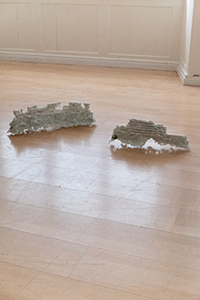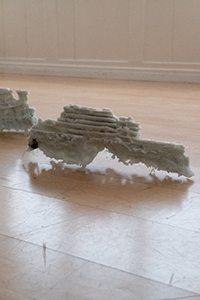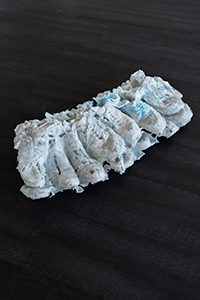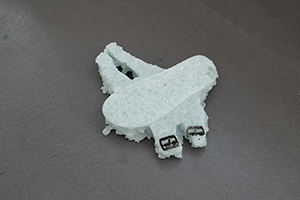

Earthly Things – Ghostly Matters
Antoine Félix Bürcher
Antoine Félix Bürcher is a Swiss artist born in Lausanne in 1999, living and working in Zürich since 2021, whose conceptual work explores form and memory through sculpture, addressing our contemporaneity and its infrastructure of the imaginary.
The passage of time and the cycle are omnipresent in his work. These themes are central to his glass sculptures, whose materials are collected by Félix, the artist’s alter ego, as he drifts through space.
The sculptures present temporalities in mille-feuilles, layers of stacked glass fused together, like the strata of rocks that bear witness to the passage of time beyond the human scale. The artist draws a nonlinear aesthetic of time, emphasizing the transitory and durable aspects of a ‘post-sublime’ reality. The work reflects the ephemeral nature of our contemporary reality, imperceptible at times, caught up in interfaces as speed accelerates towards the exponential in a finite world.
Digital artefacts, copies in motion, freeze and melt and pop out of the screen, as simulacra of natural architecture, anthropomorphic rocks from an earlier future. Ghost images, an absent presence, a stasis that contains within it the possibility of transformation. The fluid properties of glass give the sculpture a non-monumental aspect, challenging the idea of sculpture as eternal representation. Nature, however close it may be to us, needs to be understood, the glass ceiling needs to be looked at – looking at the glass instead of through it, morphing, imagining and becoming.
He holds a Master degree in Fine Arts from ZHdK (2025), a Bachelor’s degree in Visual Arts (construction, sculpture) from HEAD – Geneva (2022) and before that he studied cinema at HEAD too. He has had numerous opportunities to show his work in exhibitions such as Museum Haus Konstruktiv (Zurich, Werkschau 2023), a solo in Art Genève (2025), Plattform in 2023 (Espace Arlaud, Lausanne), Triennale der Skulptur (Bad RagARTz, Bad Ragaz, 2024), Cabaret Voltaire (Zurich, 2023), One Gee In Fog (Geneva, 2021).
Antoine Félix Bürcher, Untitled, 2050. Detail views
Untitled, 2050, 2024
The river’s flow carries with it materials, temporalities and stories - raindrops from the past, branches from a distant forest, fish thoughts and grains of sand that move like red blood cells do in our bodies. It’s always in moments of emotional intensity that I feel the need to follow a river on foot. Close to water, one feels alive and by the meandering banks, time passes more slowly. In its moving flow, water is a vessel that transports, transforms, reinforces and dilutes emotions. I’m thinking of Mina’s “fiume azzurro”, the “cry me a river”, Patti Smith’s “pissing in a river”.
Although water has never been found on the moon, we continue to believe in its presence, searching for it in the rocks. Here too, in Riverside Moonwalk the river is invisible, but not what the water carries, nor its movement: these are found in the pieces described by Félix as “performing sculptures”.
We’re invited to wander through a landscape of frozen sculptures that yet evoke a flow, both conceptually and in their very materiality. Without even touching them, you can tell that these pieces are cold, like river water. They are not made of ice, nor of wax. They are assemblages of glass, a material that is itself an assemblage of an almost infinite number of grains of sand. This glass is meticulously collected by the artist in a multiplicity of places and contexts. The different types of glass are then assembled in molds and fused together. The result is a transfer of materials, shapes and contents. The chemical reactions create a palette of colors. Different shades of blue decided to morph beyond the artist’s control.
Here, glass is no longer a transparent surface through which one observes something else; it becomes the subject and, like a vessel of emotions, contains a multitude of stories. In the molecular sense, the vitreous state is a particular state of matter, neither solid nor liquid, an in-between. Looking at the drops on the surface of Félix’s pieces, one thinks that by the next hot summer, they’ll be liquid again, and the flow will carry on.
The sculptures have the particular opacity of ghostly beings, a non-present presence, a stasis that contains within it the possibility of transformation. When we think of sculpture in the traditional, historical sense, we imagine muscular bodies fixed forever in stone, the engraving of an unchanging truth, a momentum halted forever. Here, we are reminded that with the passage of time, even the most solid stone will change shape. In the exhibition space, we might recognize branches. They’re the same bits of wood swept along by the current, polished by the water. When time slows down, the branches come together at the meander’s edge to form temporary piles.
Lying on the ground, as if levitating, the lunar forms seem to come from another ecosystem: time is stretched out, there may be no oxygen in the air. In this exhibition, we follow the flow of the river in a moonwalk - one foot after the other, sliding backwards, always in motion. The sculptures perform, their color and transparency changing with the light, and we follow the water’s course in reverse as if we were going to find back everything that had been transported. In this distorted, extended temporality, we imagine windows melting and bunkers eroding.
Ohne Titel, 2050, 2024
Der Fluss trägt Materialien, Zeitlichkeiten und Geschichten mit sich – Regentropfen aus der Vergangenheit, Äste aus einem fernen Wald, Gedanken von Fischen und Sandkörner, die sich wie rote Blutkörperchen in unserem Körper bewegen. Es sind immer die Momente emotionaler Intensität, in denen ich das Bedürfnis verspüre, einem Fluss zu Fuss zu folgen. In der Nähe des Wassers fühlt man sich lebendig, und an den mäandernden Ufern vergeht die Zeit langsamer. In seinem bewegten Fluss ist das Wasser ein Gefäss, das Emotionen transportiert, umwandelt, verstärkt und abschwächt. Ich denke an Minas „fiume azzurro“, an „cry me a river“, an Patti Smiths „pissing in a river“.
Obwohl auf dem Mond nie Wasser gefunden wurde, glauben wir weiterhin an sein Vorhandensein und suchen in den Felsen nach ihm. Auch hier, in Riverside Moonwalk, ist der Fluss unsichtbar, aber nicht das, was das Wasser trägt, und auch nicht seine Bewegung: Diese finden sich in den von Félix als „performative Skulpturen“ bezeichneten Stücken.
Wir sind eingeladen, durch eine Landschaft aus gefrorenen Skulpturen zu wandern, die sowohl konzeptionell als auch durch ihre Materialität einen Fluss hervorrufen. Ohne sie auch nur zu berühren, kann man feststellen, dass diese Stücke kalt sind, wie Flusswasser. Sie sind weder aus Eis noch aus Wachs gefertigt. Es sind Assemblagen aus Glas, einem Material, das selbst eine Assemblage aus einer fast unendlichen Anzahl von Sandkörnern ist. Dieses Glas wird vom Künstler an einer Vielzahl von Orten und in verschiedenen Zusammenhängen sorgfältig gesammelt. Die verschiedenen Glastypen werden dann in Formen zusammengefügt und miteinander verschmolzen. Das Ergebnis ist ein Transfer von Materialien, Formen und Inhalten. Durch die chemischen Reaktionen entsteht eine Palette von Farben. Verschiedene Blautöne entschliessen sich, sich außerhalb der Kontrolle des Künstlers zu verändern.
Glas ist hier nicht mehr nur eine transparente Oberfläche, durch die man etwas anderes betrachtet; es wird zum Gegenstand und enthält wie ein Gefäss der Gefühle eine Vielzahl von Geschichten. Im molekularen Sinne ist der glasartige Zustand ein besonderer Zustand der Materie, weder fest noch flüssig, ein Dazwischen. Wenn man die Tropfen auf der Oberfläche von Félix’ Arbeiten betrachtet, denkt man, dass sie sich im nächsten heissen Sommer wieder verflüssigen, und der Fluss wird weitergehen.
Die Skulpturen haben die besondere Opazität von Geisterwesen, eine nicht vorhandene Präsenz, einen Stillstand, der die Möglichkeit der Transformation in sich birgt. Wenn wir an Bildhauerei im traditionellen, historischen Sinne denken, stellen wir uns muskulöse Körper vor, die für immer in Stein gemeisselt sind, die Gravur einer unveränderlichen Wahrheit, ein für immer angehaltener Schwung. Hier werden wir daran erinnert, dass selbst der massivste Stein im Laufe der Zeit seine Form verändert. Im Ausstellungsraum erkennen wir vielleicht Äste. Es sind die gleichen Holzstücke, die von der Strömung mitgerissen und vom Wasser geschliffen werden. Wenn sich die Zeit verlangsamt, kommen die Äste am Rande des Mäanders zusammen und bilden temporäre Haufen.
Auf dem Boden liegend, wie schwebend, scheinen die Mondformen aus einem anderen Ökosystem zu stammen: Die Zeit ist gedehnt, vielleicht gibt es keinen Sauerstoff in der Luft. In dieser Ausstellung folgen wir dem Flusslauf des Mondes in einem Moonwalk – ein Fuss nach dem anderen, rückwärts gleitend, immer in Bewegung. Die Skulpturen treten auf, ihre Farbe und Transparenz ändern sich mit dem Licht, und wir folgen dem Lauf des Wassers in umgekehrter Richtung, als ob wir alles, was transportiert wurde, wiederfinden würden. In dieser verzerrten, verlängerten Zeitlichkeit stellen wir uns vor, wie Fenster schmelzen und Bunker erodieren.





